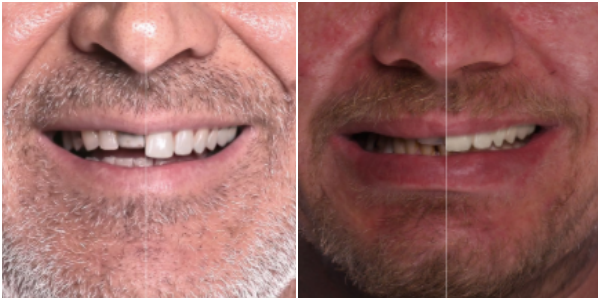DIGITAL SMILE DESIGN
Digital Smile Design (DSD) is a new way of approaching the patient that with the help of state-of-the-art technology and digital diagnostic software gives us the ability to create an accurate 3D digital look of your teeth (including a new jaw and face look) where the patient herself a co-designer of her own new smile.
In a very short time, the patient can look at their own new smile with the final result before treatment has even begun. And without any damage to his teeth, because nothing has been done on them until then.
With the help of software, with an individualized approach, we can choose the right size, uniform length and the shape (shape) of the teeth according to the profile of the head and the shape of the face. We can show you the final results before starting the treatment.

1. What to expect from the DSD process?
1. At the first DSD consultation, your doctor will ask you about your wishes, i.e., what you would like to change and what you do not like about your teeth in terms of appearance, colour, etc. The more you explain, the clearer the procedure and outcome will be. During the first DSD consultation, we will examine your teeth with an intraoral scanner, take photos and make videos of your teeth and your smile.
2. Smile Analysis: Your images and data are then transferred to a computer to get a 3D view of your mouth to plan different solutions using specialized software that takes into account your unique facial and tooth proportions.
3. Review of results: Using the software, your dentist can prepare a simulation of the appearance of your smile after the end of treatment and give you a better idea of the results. Your new smile is designed to align with your teeth, lips, and facial features as you move and show emotion, meaning the teeth on your face won’t look “fake” or unusual.

4. A treatment plan with a complete cost estimate and preparation of an offer is regulated.
5. Commencement of works: After the patient accepts the offer, rehabilitation and treatment according to the work protocol begins. The amount of visits and the waiting time depend on the treatment chosen.
6. Once the treatment is complete, the feeling of new repaired teeth and a smile will be familiar to you because you already knew what to expect, but you still enjoy it all.
Digital Smile Planning (DSD), with an individual approach, is a new, artistic branch of dentistry that uses photographs, tooth models and computer drawing to design a new patient's smile by finding the optimal shape, colour and size of teeth to suit that patient.
Our teeth, in addition to being used to chew food, dramatically affect our appearance and the image we have of ourselves. A beautiful smile, properly matched to the face, helps us look youthful, fresh and natural and boosts our self-confidence.
In designing dental restorations, there are several principles by which an aesthetic smile is created. One of the guidelines is the centre line of the face which should coincide with the centre line of the teeth to create a symmetrical smile. The line connecting the edges of the front teeth should be parallel to the line connecting the pupils of the eye. By following these guidelines ,we can create restorations that will be in harmony with the rest of the face and create a beautiful, natural smile.
In addition to these basic guidelines, to determine the shape, colour, transparency and position of teeth, it is necessary to take into account the patient's individual characteristics of face, complexion, eyes, overall figure and adjust prosthetic restorations according to these parameters to get a completely natural look.
This process involves a dentist, dental technician and, most importantly, the patient himself, who, with clear visualization with the help of a computer program, participates with his wishes and suggestions in creating colour, shape, placement of new teeth, and thus aesthetics. the whole face. In addition to the images, it is also possible to visualize the future, new appearance of the teeth with temporary prosthetic works, which leaves no room for surprises and enables a predictable outcome of prosthetic therapy.
Rare are the people who can boast of a perfectly balanced natural smile in which teeth play a major role.
Many want to resort to other solutions where they seek the help of professional teams that deal with it.
In our IDC Ružević centre, there is a team of experts who aim to find your optimal shape, size and colour of future teeth through the most modern computer methods, taking into account your specificity and individuality.
Finding the ideal smile involves a computer display of future teeth with the help of old photos, patient's thoughts, their wishes and models of existing teeth.
Expert analysis predicts the final solution that is offered to the patient through temporary prosthetic works.
In this way, the patient gets the opportunity to evaluate the work itself and can influence all its parameters until the moment of complete satisfaction.
The patient's wishes are straight bright teeth without gaps, with a proportional smile in the ideal ratio of the teeth to the gums, lips and the whole face. For a "perfect smile" it is often necessary to treat not only the teeth but also the gums and lips.
Prolongation of the clinical length of the teeth is often done, and this is most effectively done with the help of a laser, very quickly, painlessly and without any trauma. In our Centre, the laser is used every day.
Old crowns or prosthetic works, discoloured teeth, old fillings and unsatisfactory shape, position and colour of teeth and lack of teeth are the most common reasons for patient dissatisfaction.
TEETH SHAPE AND SIZE. The shape, length and width of the teeth are adjusted individually to each patient with regard to the shape of the face, and according to the principle of ideal proportions. In order to achieve an ideal smile, teeth in size and shape must be in proportion to other teeth.
The edges of the upper front teeth must follow the line of the lower lip in a smile, the central incisors ("units") are always the dominant teeth and are slightly longer than the "twins". When speaking, it is desirable that the upper front teeth are visible 1-3 millimetres. Visible upper front teeth give the face a youthful appearance. In old age, teeth are less visible due to lip atrophy. Women usually have a more moderate, rounded tooth shape, while men have a more pronounced aggressive appearance, accentuated canines, and more angular teeth.
TEETH COLOR can be changed by teeth whitening, making composite veneers, ceramic veneers, or making full crowns. Bleaching can result in several lighter shades of tooth colour, which always requires changing existing fillings that no longer satisfy the colour because their colour does not change with whitening.
THE POSITION OF THE TEETH can be changed by orthodontic therapy or, also, by making prosthetic replacements. The line between the two central incisors must coincide with the midline of the face and the tip of the papilla and be perpendicular to the edges of the incisors. Deviations from the midline are considered unesthetic and must be corrected. The teeth provide support to the lips and cheeks so that their proper position emphasizes the youthful appearance of the face.
TOOTH DEFICIENCY, apart from aesthetic, is a serious functional problem. Teeth are replaced with prosthetic therapy - bridges or crowns worn with implants. Implants are a particularly suitable solution in cases of missing one or more teeth when one wants to spare one's own teeth from grinding to make a bridge. The progress of the dental profession that accompanies the development of dental materials enables the production of highly aesthetic restorations that faithfully imitate a natural tooth with their colour and transparency, and their durability and longevity and functional stability. For a high aesthetic result, it is recommended to make prosthetic works from metal-free ceramics. These are crowns that do not have a metal but a ceramic, white skeleton in their base. That's why zircon ceramics, E. Max Press crowns and flakes are "number one" in creating the perfect smile.
GINGIVA (TEETH) is an important factor in achieving a satisfactory end result in creating the perfect smile. It must be healthy, light pink, firm and symmetrical. Inflamed gingiva (gingivitis), swollen, red, asymmetrical gingiva and recessions (withdrawn gums) impair the appearance, especially in the anterior region. Therefore, it is extremely important to repair all conditions with PROFESSIONAL TEETH CLEANING or small corrective surgical procedures in the gingival area. Removing excess gingiva, especially with a "gummy smile", gives an ideal result: gingiva that is visible in a wide smile around the upper front teeth 2-3 millimetres.
LIPS are the frame of a perfect smile, and it is possible to reshape them with a small procedure, fill in irregularities and smooth out small wrinkles at the junction of the lips and the surrounding skin. The use of preparations based on hyaluronic acid (FILLERI) with biological and biodegradable material achieves a youthful appearance of the lips. Increasing the volume of the lip or just their commissure is done as needed at the end of the tooth shaping procedure itself. You can also get this service in our Centre.
PROTOCOL
1. The patient makes appointment for free short smile-design consultations (meeting the patient and talking where it is revealed what his wishes, needs and expectations are).
2. The first short consultation to determine what can change on your smile, photographing the patient.
3. If the patient is satisfied - we go a step further. An X-ray is needed to look at the overall situation of both the tooth and the periodontium. Next, a detailed review and analysis of X-rays, fingerprints, bite registration, digital design of your new smile, making situational models, waxing with planning your new smile in wax (to visually find out what are the treatment options).
4. Preparation of an offer for the planned therapy plan within 24 hours.
5. According to the needs and wishes of the patient, we make a control test smile. If our offer and a new smile are satisfactory to the patient, we move on to the next step.
6. Time planning to make your new smile.
7. Creating a new lasting smile usually takes 7-10 days.
8. If it is necessary to include an orthodontist (sometimes necessary) and LASER procedures (extension of the clinical crown of the tooth) or some other methods of pre - preparation of the tooth to get a perfect smile, we extend the total time to create a new permanent smile for a longer period.
9. Teeth are thinned minimally (only 0.3 -0.6 mm), in some places they are not ground at all, veneers or crowns (CIRCON OR EMPRES) are made which are then glued to the teeth.
10. Photographing with the final SMILE MAKEOVER, giving instructions to the patient and making a splint as needed.
Contact Us
Menu
Home


